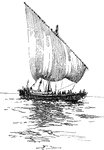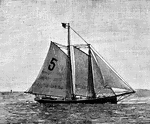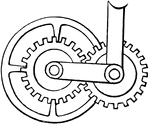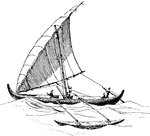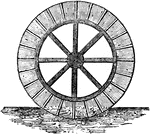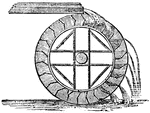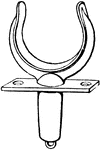
Dory
A small boat; especially a small flat bottomed boat used in sea fisheries, in which to go out from a…

Phanakistoscope
An optical instrument which the representatin of actual motion, as in leaping, walking, flying, etc.
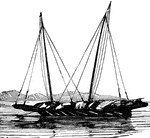
Pindjajap
A boat of Sumatra and the Malay archipelago, with from one to three masts, generally two, carrying square…

Wheel and Axle
"The wheel and axle consists of two cylinders of different diameters, rigidly connected, so that they…
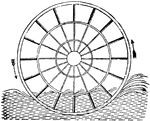
Ordinary Paddle-wheel
"The usual form of paddle-wheel, that is called the radial, in which the floats are fixed. It will be…
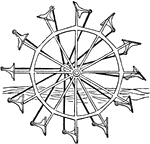
Feathered Paddle-wheel
"Elijah Galloway patented, in 1829, the Feathered Paddle-wheel, in which the floats are mounted on axes,…

Plough
"The Romans, an essentially practical nation, largely improved on the plough, adding to it the coulter…
Howard's Plough
"The plough is composed of two strong iron frames balanced upon four wheels, and crossing each other…

Press-Wheel Roller
An agricultural tool used for flattening land and breaking up large pieces of dirt.

Potters Wheel
A tool used to spin a piece of clay using converted motion from the users foot. Used mainly is making…
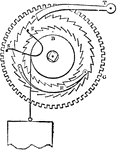
Harrison's Going-Ratchet
"The click barrel-ratchet R is set upon another larger ratchet-wheel, with its teeth pointing the opposite…

English House Clock
"A front view of a common English house clock with the face taken off, showing the repeating or rack…

Gravity Train Remontoire
"E represents the scape-wheel turning in a minute, and e its pinion, which is driven by the wheel D…

Quarter Clock
"The front view of a large quarter clock of Sir E. Beckett's design, with all the wheels on the great…

Coal-cutting Machine
"This machine consists essentially of a horizontal piston and cylinder engine fixed upon a platform…

Wheel Lock
A utensil formerly in use for containing a small fixed amount of powder and introducing it into the…

Lapland Pulk
A small canoe shaped "boat" made of light materials and covered in reindeer skin. It is drawn by a single…
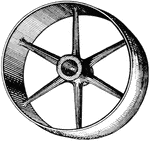
Crown Pulley
A pulley with a convex rim, much used where various cases belts are in danger of slipping off.

Flat Rope Pulley
A pulley with a sheave having its perimeter a rectangular or nearly rectangular groove. Used for transmitting…

Barlow Apparatus
"A current is caused to pass from the mercury through C along the radius of the disc A through the field…

Auto-Pneumatic Apparatus
"Hearson's machine is cylindrical in form, and is surmounted by two turrets. Internally the cylinder…

Puteli
A broad flat bottom boat, used for transporting the products of India down the Ganges. It is from 40…
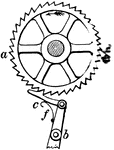
Ratchet Wheel
A wheel with pointed and anglar teeth, against which a ratchet abuts, used either for converting a reciprocating…
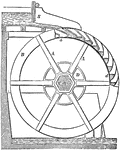
Water Wheel
"When a water fall ranges between 10 and 70 feet, and the water supply is from 3 to 25 cubic feet per…
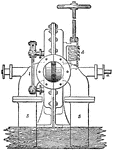
Reaction Turbine
"Professor James Thomson's inward flow or vortex turbine has been selected as the type of reaction turbines.…
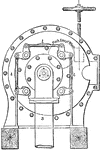
Reaction Turbine
"Professor James Thomson's inward flow or vortex turbine has been selected as the type of reaction turbines.…
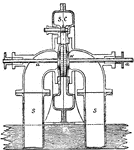
Reaction Turbine
"Professor James Thomson's inward flow or vortex turbine has been selected as the type of reaction turbines.…
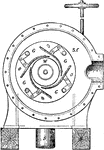
Reaction Turbine
"Professor James Thomson's inward flow or vortex turbine has been selected as the type of reaction turbines.…
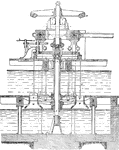
Girard Turbine
"The general sectionl elevation of a Girard turbine, in which the flow is axial. The water, admitted…
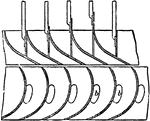
Guideblade Chamber
"The sectional form of the guideblade chamber and the wheel and the curves of the wheel vanes and guideblades,…

Guideblade Chamber
"The sectional form of the guideblade chamber and the wheel and the curves of the wheel vanes and guideblades,…

Centrifugal Pump
"A centrifugal pump differing from an ordinary centrifugal pumps in one feature only. The water rises…

Road-Racer
"Road-racer. A full roadster would have the handles a little higher relatively to the saddle, and would…

Ball-bearing Hub
"A ball-bearing hub with outward cups. The hub-shell H is turned out of mild steel, and the cups C are…

Cup-adjusting Hub
"One end of the cup-adjusting hub, with inward bearings. The cones are formed of one piece with the…

Crank-axle Bearing
"The usual form of crank-axle bearing which has inward-cups and is cup-adjusting. The end of the bracket…

Capsicum
"A genus of annual, subshrubby plants, order Solanaceae, with a wheel-shaped corolla, projecting and…
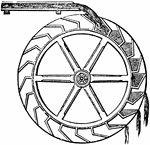
Water-wheel
"A wheel driven by water shot over the top. The buckets of the wheel receive the water as nearly as…

Chain-Pump
"The chain-pump consists of a tube or cylinder, the lower part of which is immersed in a well or reservoir,…
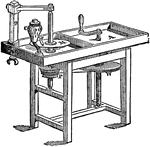
Lapidary's Mill
"In the ordinary pattern of a lapidary's bench the handle turns in a horizontal plane, where W is the…
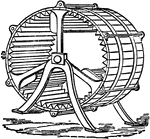
Dash Wheel
"Harness hides are washed by some means in pure water, the most convenient and generally adopted method…

Atwood's Machine
"Atwood's Machine. This difficulty has however been overcome by a curious piece of machinery invented…

Windlass
"Windlass.—The common windlass for drawing water is another modification of the wheel and axle.…
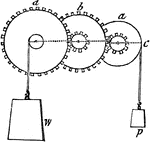
System of Wheels
"System of Wheels.—As the wheel and axle is only a modification of the simple lever, so a system…




